Montblanc Fabrication Française




It is a well-known fact that Montblanc production extended beyond Germany, including manufacturing in Denmark and Spain during specific periods of time. However, several experts believe that Montblanc also produced fountain pens in France for a brief period in the early 1940s. No official records confirm the production of Montblanc pens in France, such as advertisements or catalogues, either online or in expert-authored books. So, I embarked on personal research, meticulously exploring digital archives of French lifestyle magazines aimed at both men and women, as well as the well-known French weekly newspaper L’Illustration, focusing on editions from the 1940s. The only pen advertisements I discovered were for brands like Unic, Gold Starry, Meteore, Edacoto, Plexir, Stylomine, and Bayard, but none for Montblanc. I noticed some stylistic similarities among these pens such as their torpedo shapes and prismatic or waterfall-style clips. The torpedo shape was closer to the Montblanc made in France, and quite distinct from the shape of German-made MBs of the late 1930s - mid 1940s.
"Fabrication Française" (Manufactured in France) Montblanc fountain pen from my personal collection, early-1940s


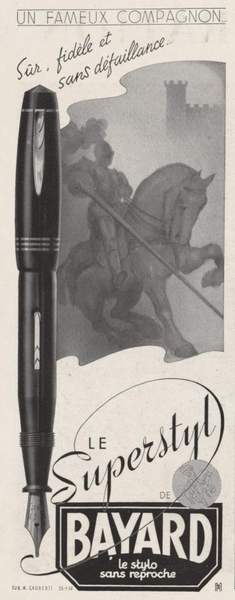


Pen advertisements from the late 1940s found in Album de la Model du Figaro, and form the early 1940s in L'illustration
There is no formal documentation to confirm that Montblanc pens were manufactured in France, one artefact supports this notion—a box labeled with the text "Stylo Montblanc; Fabrication Française'" In French, "stylo" commonly refers to a conventional fountain pen. Additionally, the phrase “Fabrication Française” clearly translates to MADE or MANUFACTURED in France. This labelling style is consistent with how Montblanc indicated the origin of production on other pens, such as “fabbricata in Germania” on German-made pens for the Italian market and “Fabricado en Espana” on those made in Spain. I acquired this box a few years ago without knowing which specific pen it was associated with, but now the connection is clear!


While this French-made pen might not be particularly desirable from a design or quality point-of-view, it is significant from a historical point-of-view in my opinion because it is evidence of an MB being produced outside of the only three places we know that Montblanc pens were officially manufactured - Germany, Spain or Denmark. Also, these pens are rare to find today - maybe because they were made for only a few years? It is not a prototype though, as claimed sometimes, because I have found other examples of this model - see pictures below...


Fabrication Française Montblanc stylographs or ink-pencils
Pic Credit: Stefan W,
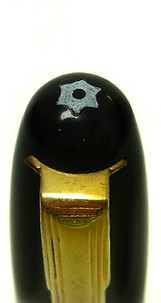

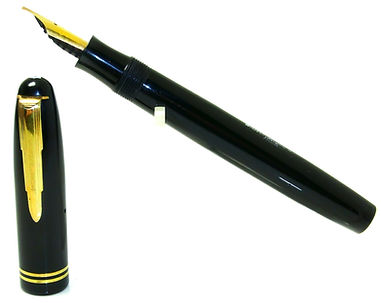
Fabrication Française Montblanc fountain pen auctioned on eBay a few years ago
Pic Credit: Waldemar S. (https://www.wasupen.com/)
There are some rather interesting distinctions in the design of the Fabrication Française Montblanc fountain pen. First notice the star on the top of the cap - it is small and has rather pointy edges. Next, notice the Montblanc imprint with the mountains on the barrel - an imprint that is typically found on the cap of the German manufactured pens. There is also a curious bore / hole in the barrel. I have seen these mostly on pneumatic fillers of different kinds because the hole plays a key role in the function of the filling mechanism. But, I haven't noticed it on button fillers very often. I assumed it was an air vent to allow the ink sac to expand more efficiently, because when I used the pen I was struck by how effortlessly the pen sac filled up all the way and dispelled ink out equally effectively in comparison to my other button fillers. My hunch was confirmed by one of our pen community's most respected pen engineers. The feed is not like those on the German models either, and resembled aspects of Waterman JiF feeds to me.


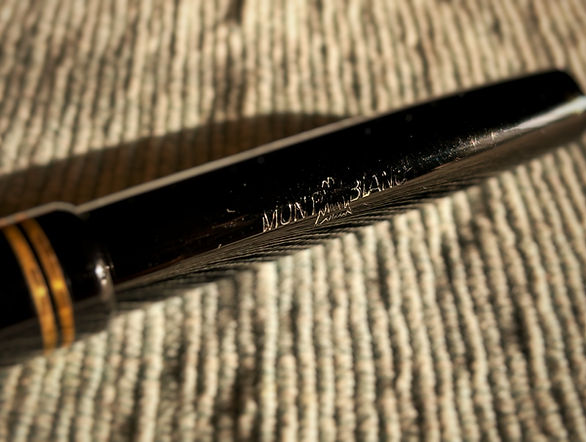
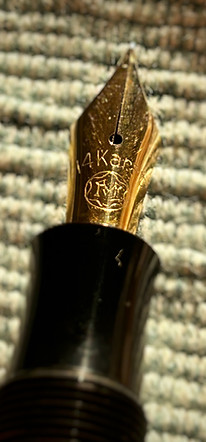
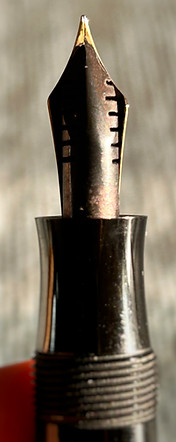
The nib on my pen is a Danish replacement gold nib. The original nib should be a steel nib. I have confirmed this with experts and a few collectors that own these pens. See picture below for the correct nib...

Fabrication Française Montblanc fountain pen with original steel nib
Pic Credit: Tom W.
Why would Montblanc decide to manufacture pens in France? Normally, there would have been a few potential reasons to set up production outside Germany. It helped to lower production costs, keep investments in the importing country, and it allowed the circumvention of import restrictions or high customs duties that made it costly to import pens from Germany. Another reason might be that during and after World War I, German products faced significant production and distribution challenges. Selling an expensive German-origin pen in the highly patriotic markets filled with resentment towards Germany (like France, presumably) was particularly difficult. Pierre Haury’s book, Une Affaire des Stylos (1990), mentions that the disruption of pen supplies to France by Allied countries during World War II led to the creation of many small pen enterprises. For example, Plexor - the importer of Parkers - started manufacturing on behalf of Parker and even making its own brand pens when importing from the US became unfeasible.

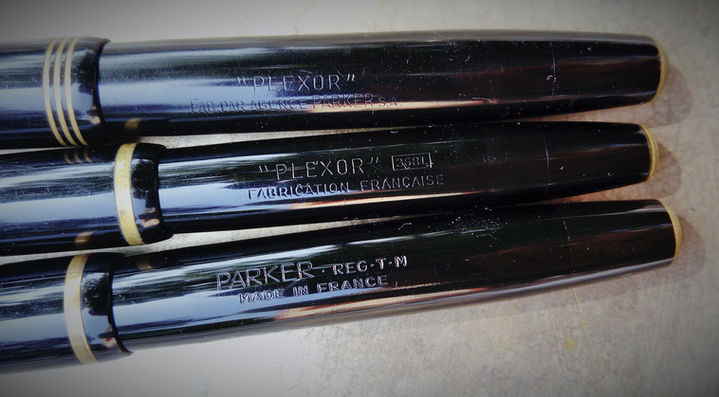
Two Parker Vacumatics (outer ends) and two Plexor Vacumatics (black)
Pic Credit: Toltotoll
Plexors and a Parker made in France
Pic Credit: Toltotoll
This smae problem might have prompted a France-based company to produce Montblanc pens in France itself - just like the Danish distributer Øberg decided to do in the 1930s. And just like Øberg did in Denmark, the distinct shapes of Montblanc pens made in France might have been designed to better suit the local market taste at the time. This is illustrated by the "Night & Day" style Montblanc pens, which resembled a well-received French Waterman design earlier in the 1920s. It might have been easier to persuade the French public to purchase the pens if they appeared less German.

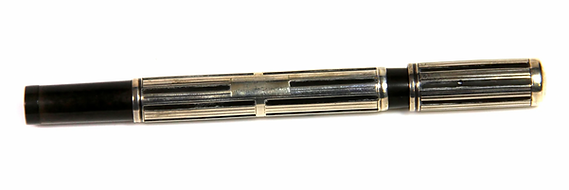
Montblanc Night & Day Safety, with a No. 2 replacement nib
Pic Credit: Christian Ott
Waterman Night & Day
Pic Credit: Gary Lehrer
Another question that comes to mind is - who took on the manufacturing? We know it was Øberg and team in Denmark, and it was Weise in Spain. But who took on the production in France? My first theory was that the French-made MBs were manufactured by J.M. Paillard - the first official Montblanc distributor in France. The origins of Paillard trace back to 1788. Over the years, the company changed ownership several times before finally being established as "Société Anonyme des anciens Établissements J. M. Paillard" in the early 1900s. Initially, the company set out to be a manufacturer of watercolors and stationery, similar to Pelikan. However, from the late 1920s, JM Paillard began producing its own fountain pens. An example of one of their pens made in the 1940s bears a strong resemblance to the Montblanc discussed in this article.
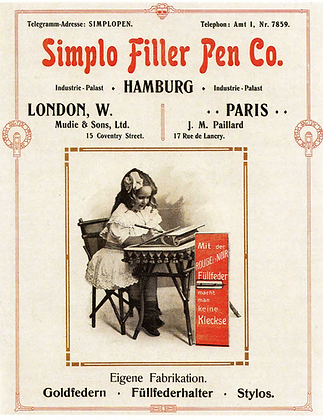
1909 Montblanc catalogue
showing J.M. Paillard as authorized dealer

1940s J.M. Paillard fountain pen
Pic Credit: https://atelier-lesoon.com/
While Paillard is shown as the distributor in some advertisements in the 1920s as well, adverts from later in that decade show Canetti & Cie as "general agents" and then "Toutluxe" as the general agents. The addresses of Canetti & Cie and Toutluxe are identical so I presume it was the same company that just changed names. The only information I could find about these companies was that Canetti & Cie was selling cosmetic equipment in the late 1920s (link). Considering this, changing their name to "Toutluxe" (translating to "Everything Luxury") makes sense. In any case, the main point here is that if Paillard was no longer the MB agent in the 1930s or 40s, then my previous theory that they manufactured MBs in the 1940s is unsupported. Who then made these pens?

1920's French advertisement
mentioning Canetti as "general agents"
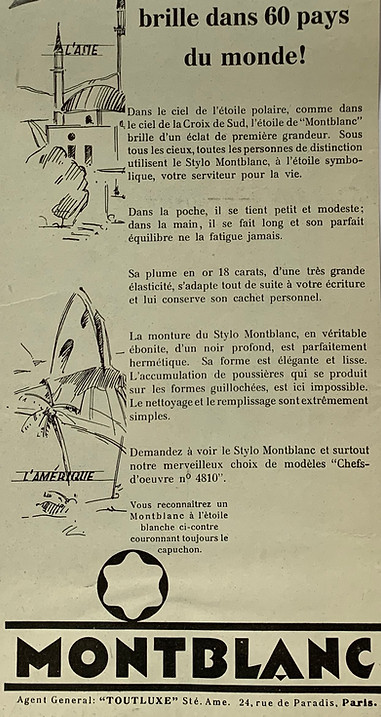
1928 French advertisement
showing "Toutluxe" as general agent
My research found nothing! However, one of the most well-known experts in our pen community presented me with an answer. He explained that these pens were made by a French company that produced writing equipment under the name Montblanc, but without the consent or affiliation of the original Montblanc company. After Germany's defeat in WWII, the French government confiscated all German properties abroad—including trademark rights—as a form of reparations. This scenario was not unique to France; a similar situation occurred in Denmark, where the brand was confiscated by the Allies but was soon reacquired with the assistance of the Danish agent Öberg. In France, these rights were then awarded to a French woman, whose name needs further research. But, our expert claims that documents from Montblanc mention that in the early 1950s, company managers traveled to France to retrieve these name rights from the woman. Thus, this French entity was essentially operating independently, utilizing the Montblanc name without any formal ties to the actual Montblanc company. If this were true, it would explain many things like why there is zero official documentation of Montblanc pens being made in France, why they were made for such a short time, etc. Maybe we will find some empirical evidence on the matter in the future.
The history of Montblanc pens being produced in France remains largely obscure. If you have any knowledge or possess examples of Montblanc pens made in France, I encourage you to reach out to me. Your insights and contributions could significantly enhance the depth and accuracy of this article.
For bibliography, see Resources page - link